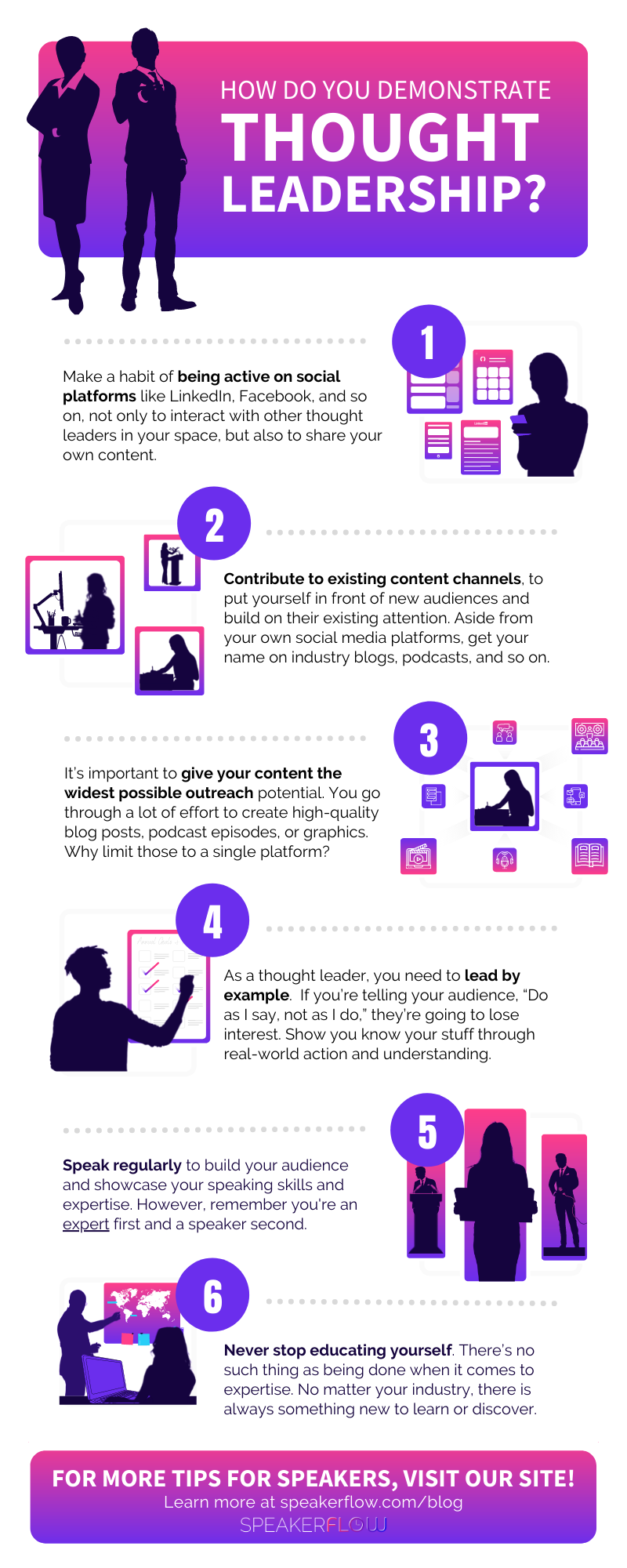Thought leaders earn trust within their field of expertise. These are the go-to people for industry trends, changes, and improvements. While most professionals would love to be considered a thought leader, this is easier said than done. How do you demonstrate thought leadership?
It’s not enough to talk the talk. You also have to walk the walk. Thought leaders speak at events, share expertise, and lead their chosen industry. In other words, a thought leader is a trusted expert. However, trust is something that’s earned over time. There are no overnight fixes, and there are no schemes to become a thought leader with any magic tricks.
Better yet, the benefits of being a thought leader are beyond the personal level. It’s also a marketing opportunity for your own brand, speaking business, or consulting. This is why some of the best-known founders, CEOs, and innovators are considered thought leaders. If a company or brand is great, it must have a thought leader behind it, right? It’s this thinking that gives thought leaders so much influence over their individual spaces.
With that in mind, how do you demonstrate thought leadership in practice? It’s not enough to call yourself a ‘thought leader’ on your resume or LinkedIn page. You have to put your money where your mouth is. This is an accolade that’s earned. While there might not be any formal degree or course for thought leadership, you can take actionable steps with the help of this guide below.
- Build your presence on social media platforms.
- Contribute to existing content channels in your industry.
- Share your own content in a variety of ways.
- Always follow your own best practices.
- Speak regularly, but remember you’re an expert first.
- Never stop educating yourself about your focus industry.
- Show Your Expertise Every Day
Build your presence on social media platforms.
First, every thought leader needs a presence on social media. You can’t demonstrate thought leadership if you’re hard to find. It’s not enough to have the best knowledge if you’re keeping it to yourself. Thought leaders are willing to share their expertise with others in accessible ways, like through social media.

When you’re active on platforms like LinkedIn, Twitter, and so on, your customer takes notice. Not only can you interact with other leaders in your space, but you also share your own content with the world. However, your social media platform needs to be curated with your thought leadership in mind.
Average consumers want to follow brands and professional pages. With 57% of consumers following a brand to learn about new products or services, this is an important way to keep your customers engaged. Whether you’re trying to build your following or land paid speaking gigs, you can build your presence on social media from scratch. Here’s how:
- Stay consistent: First, create a consistent, professional profile. This should reflect your industry and expertise. If you’re active on multiple platforms, keep your username, image, and tone consistent.
- Share your social: Share your social profiles on your website, business card, or at networking events.
- Create content: Your social media presence won’t go anywhere without curated, industry-specific content. High-value content is sharable, and it positions you as a leader in your space.
- Post regularly: Don’t post and ghost on social media! You want to contribute to your pages regularly, whether you post once a week, daily, or so on. Find a schedule that works for you.
- Stay visual: With 82% of marketers today saying video and images are the most important type of content, make sure you include visual content in your strategy.
Contribute to existing content channels in your industry.
Next, be active in your industry. If you’re wondering how to demonstrate thought leadership, the answer doesn’t have to be complicated. When you contribute to existing content channels, you put yourself in front of a new audience. Aside from your own social media platforms, get your name on other industry blogs, podcasts, and so on.

This type of content distribution is known in the marketing space as ‘earned’ distribution. That means you have less control because you don’t own the resource yourself. Because it’s harder to get a placement on these types of channels, they’re more worthwhile for your audience. These channels already have a trusted audience, and that means this trust extends to you as well. What types of earned content distribution channels are there?
- Guest post: You can guest post on industry blogs, guides, or case stories. This builds brand awareness and it’s also a powerful way to generate leads.
- Mentions: It’s also possible to get mentioned or earn a shout-out on a brand blog, social page, and so on. This leads to referral traffic and social proof.
- Podcasts and videos: In our visual and audio-focused world, these mediums are becoming more powerful than ever. If you’re featured as a guest on a video or podcast, this is a great way to show your expertise.
- Email campaign: Lastly, you could also guest contribute to an email campaign, especially for an industry-specific email blast.
In other words, the more you get your name and ideas out there, the better. How do you land these earned distribution channels? While they won’t happen overnight, the best way is through authentic networking. When you’re connecting with industry platforms and leaders on social media, you build a relationship over time. From there, don’t be afraid to ask for value-rich contribution opportunities.
Share your own content in a variety of ways.
Similarly, share your own content in multiple different ways. This means you include both different types of content and you share across platforms. Also known as multi-channel marketing, it’s important to give your content the widest possible outreach potential. You go through a lot of effort to create high-quality blog posts, podcast episodes, or graphics. Why limit those to a single platform?

What types of content can you produce? Some ideas are:
- Blog posts and guides
- Ebooks
- Infographics
- Email newsletters
- Videos
- Podcast episodes
- Live videos or webinars
- Testimonials and reviews
- Contests
From there, your content should be shared across platforms. For example, you might share a blog post on your website, social media, and email blast. Then, you might repurpose it into a shareable infographic. When you repurpose existing content, you stretch your value even further. Because different audiences like content in different forms, this broadens your reach. If you want to know how you demonstrate thought leadership, it’s by promoting yourself with skill and expertise.
Let’s look at an example to see how you can use your existing content in a variety of ways. Melyssa Griffin is a thought leader who encourages her audience to start their own successful digital businesses. Though you can find her content in written form on her blog, you can also find her content repurposed for her podcast, online courses, and on her social media profiles. This is a way for her to work smarter, not harder, taking her content to new heights while promoting herself as a thought leader.
Always follow your own best practices.
Moreover, practice what you preach. As a thought leader, you need to lead by example. It’s not enough to say you know what you’re doing. Show through real-world action and understanding. One of the surest ways thought leaders gain consistent followers is by being an example for their audience. If you’re telling your audience, “Do as I say, not as I do,” they’re going to lose interest. Even worse, they might think of you as a hypocrite.

Following your own rules projects authenticity, which attracts followers as they watch you succeed. People want to follow others who are successful. If you haven’t reached success of your own, it’s important to focus on this before you position yourself as a thought leader. This means understanding your industry-specific best practices, then making them your own.
A shining example of this is SEO thought leader Neil Patel. Founder of Crazy Egg, KISSmetrics, and more, he is continuously recognized as a top influencer in the search space. As an SEO leader, he helps his audience gain more traffic to their websites. He has a simple 4-step process that anyone can follow to build a successful website from the ground up. However, this isn’t what makes him stand out. He’s so trustworthy amongst his audience because he practices what he preaches.
He doesn’t just tell his audience to post on their blogs or to use keywords. He does these things himself, learns from them, and then shares his experience with his audience. By leading by example, it’s easy to see how he’s carved a name for himself in this competitive space. With almost half a million followers on Twitter alone, he’s not afraid to put himself out there.
Speak regularly, but remember you’re an expert first.
Furthermore, don’t be afraid to speak regularly. Thought leaders aren’t found at home or tucked away in their offices. They’re out there in the world speaking about their expertise. Not only do speaking gigs build your audience, but they’re also a chance to show your skills. However, make sure you don’t slip into thinking of yourself as a speaker first and expert second. In reality, it’s the other way around.

While it’s possible to consider yourself another title in addition to thought leader (consultant, educator, author, coach, speaker, etc.), your primary focus should be your expertise. If you’re just starting as a thought leader, you might not be sure where to begin when it comes to speaking engagements. This can be taught at first, but it becomes easier over time. Some basic steps to get you started include:
- Expertise: First, hone in on your craft. Make sure your skills as a speaker stand out. Above all, be sure you have a clear area of focus within your industry.
- Speaker bio: From there, develop your speaker bio and media kit. This should highlight your speaking topics, past engagements, professional accolades, and testimonials. In other words, it sells your services.
- Marketing: Start marketing yourself as a thought leader and speaker. Though you’re an expert first, your speaking is another component of your business.
- Identify opportunities: At first, opportunities probably won’t fall in your lap. Begin looking for speaking opportunities, explore open calls for speakers, and promote yourself within your space.
- Speak for free: Finally, don’t be afraid to start speaking for free to build your expertise. This is a great networking opportunity, and a reference is well worth working for free.
Never stop educating yourself about your focus industry.
Last but not least, never stop educating yourself. There’s no such thing as being done when it comes to expertise. This is a lifelong process. No matter your industry, there is always something new to learn or discover. Today more than ever, things move fast. You can never be too comfortable.

If there’s something we can learn from the COVID19 pandemic, it’s that you have to be ready to adapt. When things go wrong unexpectedly, you need to keep your wits about you. For example, in the speaking space, the pandemic meant speakers suddenly lost their gigs. Those who were prepared and forward-thinking were ready to adapt. These are the thought leaders whose businesses lived to see another year.
How do you keep educating yourself? It doesn’t have to be complicated. In many cases, it’s just about staying proactive. There’s no such thing as knowing ‘too much.’ Make these steps below a part of your regular routine to stay agile:
- Read industry blogs
- Follow other thought leaders
- Explore whitepapers and new research
- Consider trends in your industry
- Network at events
- Attend conferences and shows
- Be active on social media
Show Your Expertise Every Day
Ultimately, the best thought leaders know the power of showing rather than telling. It’s easy to call yourself a so-called guru or expert. However, how do you demonstrate thought leadership in practice? It takes hard work, dedication, and real expertise. If you’re following these tips above, you’re already on the right track.
Now is the time to build your own foundation as a thought leader. The world is a wide place, but there is always room for more experts. How will you market yourself apart from the crowd?







